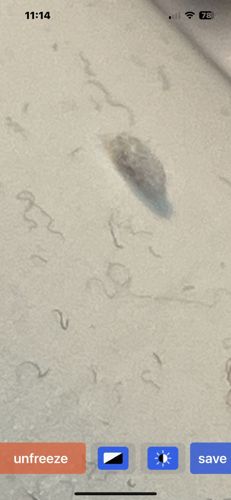Nematode (Roundworm)
Scientific Name: N/A (Broad classification: Phylum Nematoda)
Order & Family: Phylum: Nematoda (No single Order/Family can be identified from the image due to the general appearance).
Size: Most free-living nematodes are microscopic, typically ranging from 0.05 mm to a few millimeters in length. Parasitic forms can be larger, with some reaching several centimeters or even meters in length (e.g., certain parasitic roundworms).

Natural Habitat
Nematodes are ubiquitous, found in almost every environment on Earth. They are abundant in soil, freshwater, marine environments, and as parasites within other organisms. Free-living forms thrive in moist conditions with organic matter.
Diet & Feeding
The diet of nematodes is highly varied. Many are free-living and feed on bacteria, fungi, algae, and microscopic organisms in soil and water. Others are parasitic and feed on plants (phytonematodes) or animals, including humans (parasitic nematodes). The specific diet depends on the nematode species.
Behavior Patterns
Nematodes are typically worm-like in movement, wiggling their bodies to move through their environment. They can be found in high densities and often aggregate. Their life cycle can be direct (egg to adult) or involve multiple hosts depending on the species.
Risks & Benefits
Risks: Many species are parasitic and can cause significant diseases in plants (e.g., crop damage), animals (e.g., heartworm in dogs), and humans (e.g., ascariasis, hookworm, pinworm). Benefits: Free-living nematodes play a crucial role in nutrient cycling in ecosystems, particularly in soil health and decomposition. Some are used as biological control agents against insect pests.
Identified on: 8/27/2025